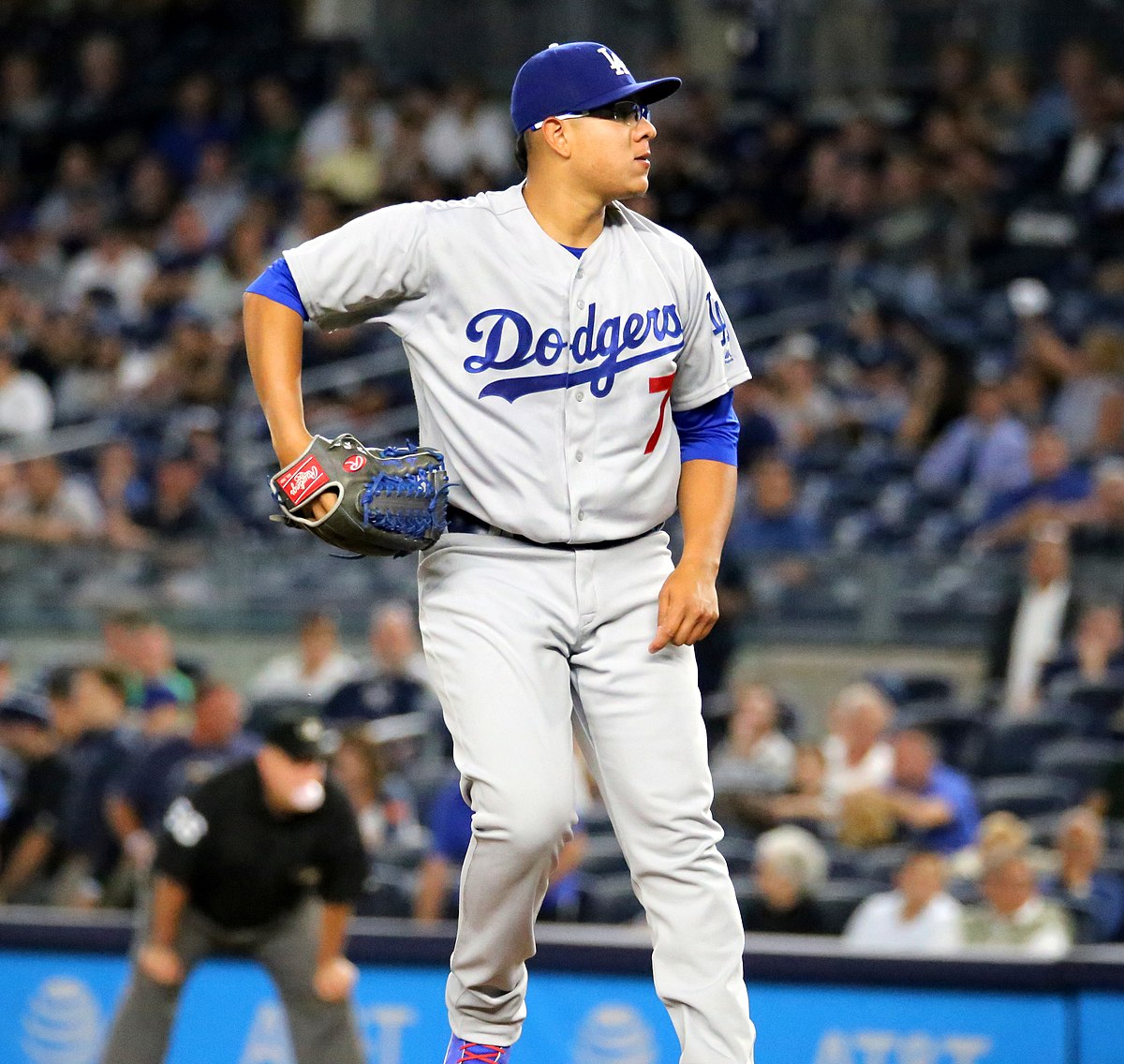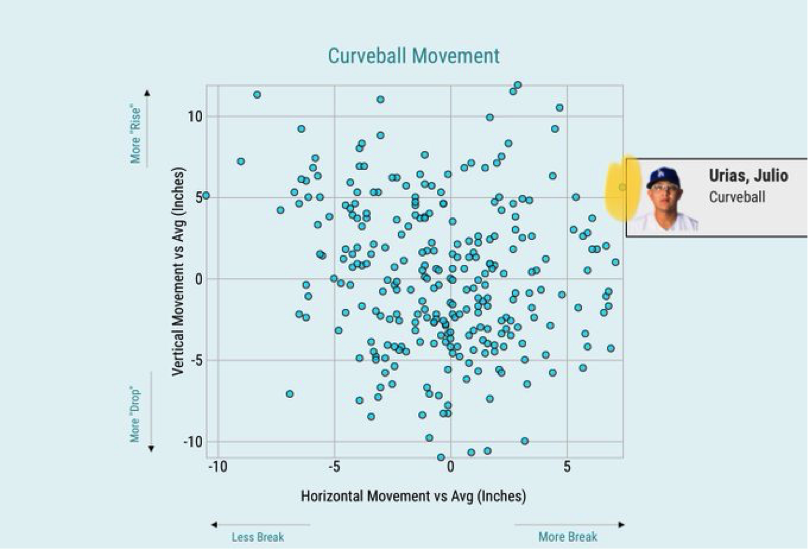Look for Julio Urias and his Signature Curve to Break Out in the World Series

Last Sunday’s Game 7 was as exciting as a baseball could hope for, featuring a dramatic go-ahead home run by Cody Bellinger and an “all-in” approach to bullpen management with both teams teetering on the brink. After scrapping a largely unsuccessful Dustin May opener strategy and keeping Tony Gonsolin in for a batter or two too long, Dave Roberts finally pushed the right button when Julio Urias entered just before Bellinger’s dramatic blast and went on to retire all nine Atlanta batters he faced.
With a handful of options after Clayton Kershaw and Walker Buehler’s start days, Urias has cemented himself as the Dodgers third starter and key swingman, something they desperately need, heading into the Fall Classic with an altered pitch mix that has brought out the best in the young left-hander.
Urias was superb on Sunday, going nine up and nine down through the Braves’ dynamic lineup. And while he didn’t record a single strikeout, it wasn’t simply a stroke of luck from the BABIP gods. He allowed just two hard-hit balls in play (95 mph exit velocity or higher) and only two batted balls with an expected batting average (xBA) over .400, factoring in both the quality of contact and the launch angle.
His key relief outing followed a terrific Game 3 start, lost in the shuffle of the Dodgers’ 15-3 rout of Atlanta that got them back into the series. After most casual fans had already changed channels after an 11-run top of the first, Urias cruised through five innings, fanned five, and allowed just a solo shot to Braves rookie Cristian Pache in the third. This postseason, the Dodgers’ former No. 2 prospect as recently as 2015 has allowed one earned run in 13 frames, all coming in relief save for his one NLCS start. His recent form along with his pedigree make him the Dodgers best option to start a Game 2, with Buehler currently lined up for Game 3 Friday night.
Still only just 24 years of age, it already feels like Urias should be approaching his 30’s with how early he made his Major League debut. He emerged as a rising star through the Dodgers system after signing in 2013 out of Mexico at age 16. The southpaw began his minor league career in full-season ball, where he was nearly 6 years younger than the average player at that level. He threw a perfect inning in the 2014 Futures Game a year later, becoming the youngest ever participant in the event (17) and was in the Big Leagues midseason in 2016 at age 19. After taking the ball to begin a Game 4 against the Cubs in 2016, he became the youngest starter in postseason history. Most of his 2017-18 seasons were washed away by shoulder surgery.
As a consensus top-10 prospect in the game prior to the 2016 campaign noted for his impressive “feel for pitching” well ahead of his years, he hasn’t lived up to the hype just yet but this is the norm rather than a disappointing exception. Very few young players come up and excel right from the start, particularly pitchers who are oftentimes a mechanical adjustment or a pitch away from building an arsenal that makes them an All-Star caliber player. Entering this postseason, Urias has accrued a meager 3.3 rWAR in his career, with a full win coming behind a very strong 2020 season. Since the turn of the century, only 24 pitchers have reached the 10 WAR threshold before turning 25, an arbitrary qualifier I’ve chosen that averages out to less than 2.0 wins a season if debuting as a teenager, hardly a perennial All-Star. This is all to say that Urias has lived up to expectations yet, but is just coming of age relative to his peers and is only just starting to approach his lofty ceiling.
2020 has been Urias’ best season to date, reaching 1.0 rWAR for the third time in his career despite the shortened season. The biggest difference in his pitch mix this year has been to largely scrap his slider and lean heavily into his signature curveball. As noted in an earlier link about the 2016 NLCS above, Urias has made changes with his breaking ball in the past, altering the grip to give the pitch more vertical movement like a traditional 12-6 hook. This year, he’s gone back to his signature side-sweeping curve, with the offering featuring 15.3 feet of horizontal movement, the most of any curveball in baseball this year. Here’s a visual representation of the outlier pitch’s unique movement profile:

This type of horizontal movement makes the pitch a tantalizing offering to neutralize opposite-handed hitters as well as those from the same side. It has the appearance of a pitch they can handle on the inner-third and then sweeps inside to bust in on the hands like few other pitches in the game do and the numbers back it up. Throwing the offering at a career-high 22.5% rate this year, Urias’ opponents are hitting just .162 (6-for-37) off it with a .216 slugging percentage. It has made his fastball play even better, another offering with above average spin that he gets his majority of swings-and-misses on (25.7 whiff% and a .193 opposing average).
While his strikeouts are slightly down this year, Urias’ tweaks in pitch mix have helped him limit hard contact better than before with his wOBA against (.255) and expected wOBA on contact (wOBACON, .306) both marking career-bests. His hard-hit percentage was in the 91st percentile in baseball. He’s finally starting to tap into the potential that netted him a seven-figure signing bonus as a teenager and a key reason why Andrew Friedman felt comfortable losing previous starting rotation stalwarts like Hyun-jin Ryu, Kenta Maeda, and Ross Stripling over the past year.
There is going to be an understandable level of skepticism for any “breakout performance” in this shortened, bizarre 2020 season but we should pay attention when it comes from a player like Urias. He’s still only 24 and has shown an acumen and willingness for making necessary adjustments to succeed. But most important of all, he was handed three crucial innings in the most important game of the year for the Dodgers so far. Don’t be surprised when Urias has a major coming out party in this year’s World Series.
















